AN OLD MAN AND HIS TOYOTA FJ CRUISER: PART ONE
By Warren Eastland
I live beyond the end of the paved road and I play even further in the Back of Beyond. Because of that, I need a vehicle that can reliably take me out and reliably bring me back. In addition it has to be a “daily driver” (even though I don’t actually drive on a daily basis) that can take me on road trips across Canada and the United States.
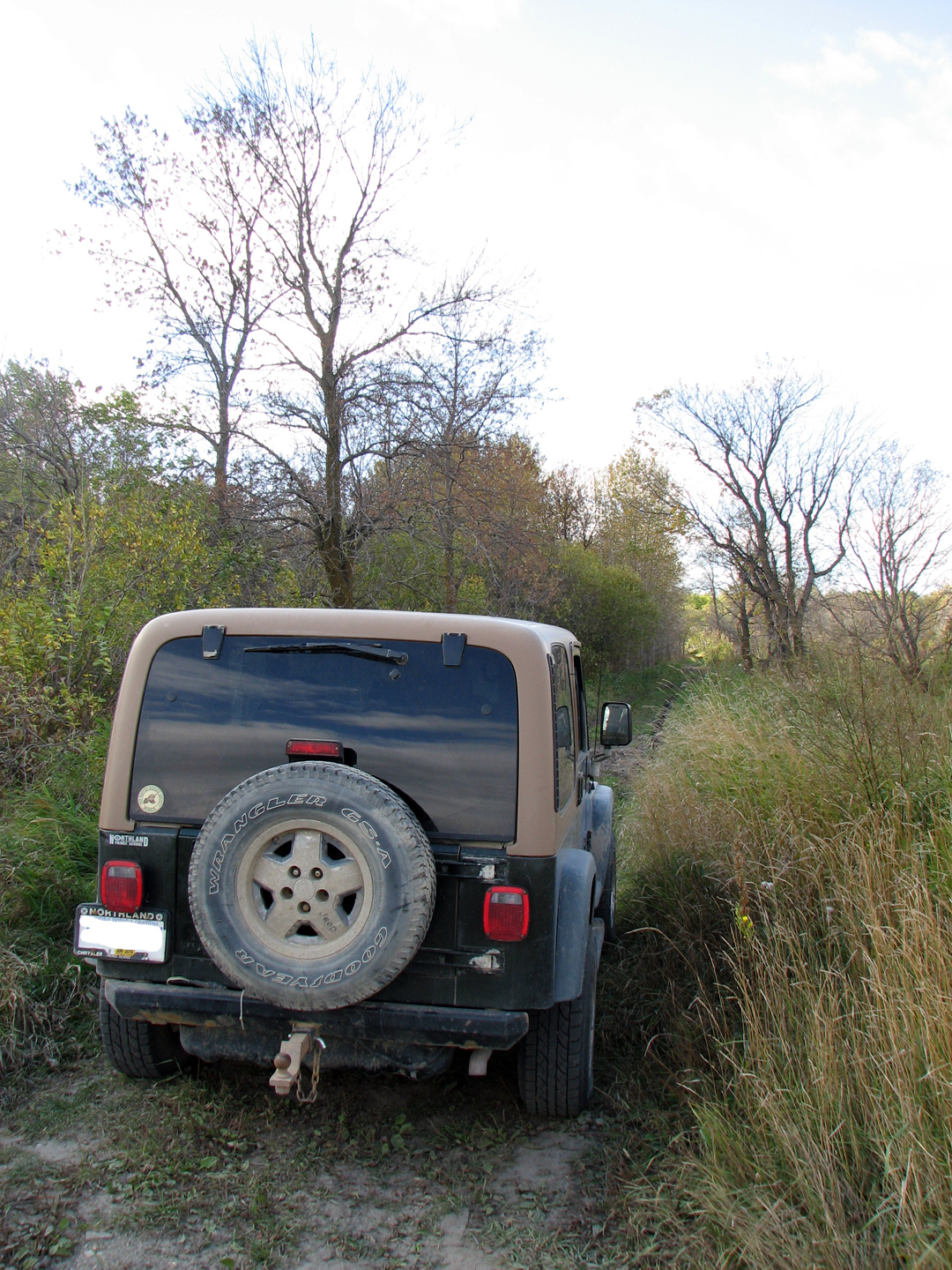 For a couple of decades I had a Jeep Wrangler that did that duty and did it well, but it did it completely without comfort. At temperatures that would turn honey solid, I had to wear full arctic gear if I wanted to go anywhere; parka, overpants, mittens or gloves, heavily insulated boots, and the like. When traveling in areas a lot further south than where I live, or later in the season, I’d just keep both windows (yep, just two: one on the driver’s and one on the passenger’s side) rolled down. Forget about listening to the radio or conversing with a passenger, because the “ambient noise” was just overwhelming. But it would take me out into the bush and bring me back.
For a couple of decades I had a Jeep Wrangler that did that duty and did it well, but it did it completely without comfort. At temperatures that would turn honey solid, I had to wear full arctic gear if I wanted to go anywhere; parka, overpants, mittens or gloves, heavily insulated boots, and the like. When traveling in areas a lot further south than where I live, or later in the season, I’d just keep both windows (yep, just two: one on the driver’s and one on the passenger’s side) rolled down. Forget about listening to the radio or conversing with a passenger, because the “ambient noise” was just overwhelming. But it would take me out into the bush and bring me back.
Eventually, on orders from The Boss, my 20-year-old Jeep was turned out to pasture and I ended up with a 10-year-old FJ Cruiser that I knew had been meticulously maintained (How did I know? Because it had been The Boss’s before she got to wanting a few of the features of something a bit more modern). The FJ, stock, is an interesting vehicle. It was actually designed to go beyond the pavement, having electronically activated rear differential lockers, limited-slip differentials both fore and aft, and a host of other traction-aiding gear. It has the ground clearance of a truck along with skid plates, protective gear, and other design features that allow it to effortlessly handle the two-track trails that go into places most folk never see. But it also has amenities my Jeep lacked: among these are as a heater that actually warms the interior, seats with padding, and even air conditioning. In some ways it’s less than ideal for a city vehicle: rear visibility is limited, a drawback partially ameliorated starting in the 2010 model by a back-up camera (mine is a 2008). When I wasn’t so gray as I am now I’d driven a pick-up truck—for a quarter-century—with even less rear visibility, so that was no big deal.
The FJ’s turning radius reflects its truck heritage, the back seats are suitable for children and dogs only, and internal stowage space is limited. But it would do what I needed it to do, with a bit of modification, both in town and beyond; so it succeeded (notice how I cleverly avoided saying it “replaced” the Wrangler).

ALL THE WAY TO THE BACK

My first task was to improve the rear storage space. There was no way I could actually increase the space, but I could modify it to decrease the amount of wasted space. A bush vehicle must always carry basic pioneering gear such as axe, shovel, fire extinguisher, a bumper jack, tow straps, and essential repair equipment. If you’re leaving for the bush, you’d better add in a tent, a sleeping bag and pad, a stove, cooking gear, and...and...and. But with all that dumped on the rear deck, as you can see in this picture, there wouldn't be any reasonable amount of room for groceries and the sorts of things one collects in town. Remember, the FJ is my “daily driver” besides being my bush vehicle.
I have the advantage of having a few woodworking tools and the knowledge of how to use them, so I went to work, building a shelf, creating a space where the necessities of such a truck could be stowed. Since camping gear wasn’t along on every trip, it could be put on top of the shelf when required.
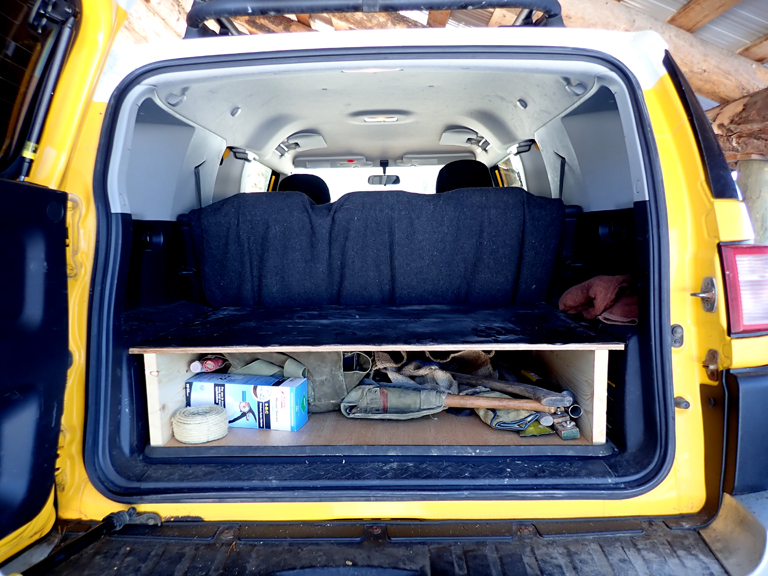
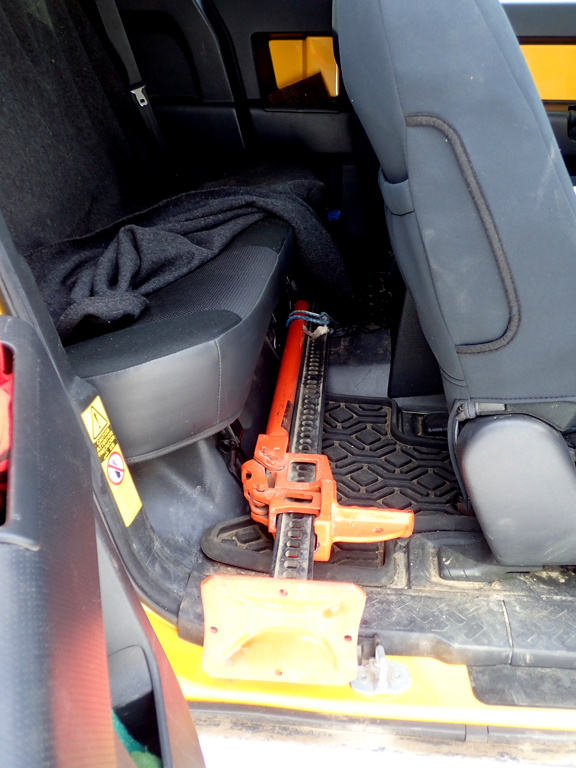 The shelf was made by planing down a 2x4 and a 2x6 to slightly more than an inch thickness; then they were tongue-and-groove joined together. Because all lumber is described as the dimension before sawing, the boards were about nine inches tall when joined. I added a bit of paneling that I had left over from a previous project as a bottom, plus a bit of similarly-left-over half-inch plywood as a top. Using contact cement, I covered the top with a thin (one-eighth inch) layer of rubber to prevent whatever I put on top of the shelf from sliding around too much.
The shelf was made by planing down a 2x4 and a 2x6 to slightly more than an inch thickness; then they were tongue-and-groove joined together. Because all lumber is described as the dimension before sawing, the boards were about nine inches tall when joined. I added a bit of paneling that I had left over from a previous project as a bottom, plus a bit of similarly-left-over half-inch plywood as a top. Using contact cement, I covered the top with a thin (one-eighth inch) layer of rubber to prevent whatever I put on top of the shelf from sliding around too much.
My basic self-extraction gear (minus the bumper jack) fits in there. If I find that things roll around and rattle (and maybe even if they don’t) I can build a box to fit into the space below the shelf. The bumper jack goes on the floor in front of the rarely-used rear seats.
HAZARD AND RISK
For reasons known only to Toyota, the console well in between the two front seats has no cover, but that was an easy fix. I took a piece of walnut—again, left over from a previous project—and made a console cover that kept my elbow from disappearing into its maw when I leaned sideways. Rather than try to hinge it to the rim of the console well, I just made a couple of blocks so that it wouldn’t slide around; gravity would do the rest.

"Risk" and "hazard" are often treated as if they’re the same thing but they’re fundamentally different. An asteroid falling on Earth and hitting me is quite hazardous to my health; it’d kill me. I don’t worry about that, though, because the risk is so infinitesimal that it can’t be calculated. Leaving aside the human propensity to disregard routine dangers such as a car accident (something both hazardous and with a measurably high risk), some people are simply not happy unless they’ve got something to worry about.
I’ve driven something over a million miles (likely double that) and my wife has driven her million. In over a half-century of driving over 100 times around the earth, neither of us have ever been in, nor been at, a car wreck so severe that a vehicle window needed to be broken and the safety belt had to be cut to extract someone from inside. High hazard, should you get really pancaked into the vehicle while leaving the windows intact and the safety belt buckle get jammed, but of quite low risk. Nonetheless, my wife wanted, and bought, one of those hammer gizmos designed for breaking tempered safety glass, and with a built-in nylon strap cutter for slicing through jammed seatbelts.  Once she had hers, she decided that I certainly needed one as well.
Once she had hers, she decided that I certainly needed one as well.
Luckily however, she had consulted with a neighbor who suggested something more compact that had a few other possible uses, a fold-up sort of thing (to save space) that comes in its own little can for storage. One of the additional features of the gizmo is a small flashlight, which might be useful, so I decided to put it someplace where I could get to it when I wanted it. A vehicle is a type of ship and it only has so much stowage space: once it’s full, it’s full. Adding anything means that something else must come out. I’m far from reaching that point with the FJ, but I also want to postpone that possibility as long as possible, so I try to be as efficient as I can when stowing things. My choices were to bury it at the bottom of a pile of immensely more useful stuff, or to stow it where I could actually get to it.

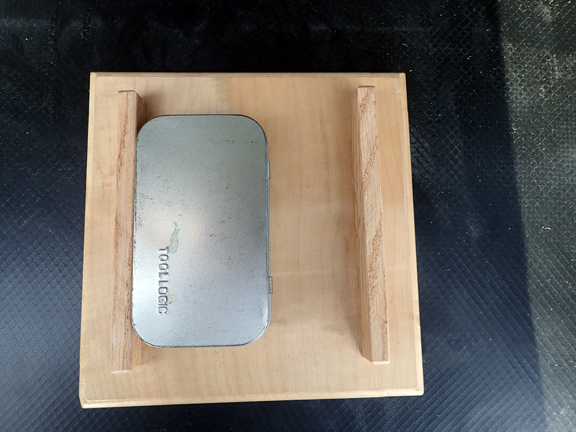
A few (very few) unused cubic inches on the bottom side of the console cover was the solution. This location also has the benefit of being equally accessible to both the FJ’s driver and passenger. I put some self-adhesive hook-and-loop material (more commonly called sticky-back Velcro) on the bottom side of the console lid and the matching piece on the bottom of the can, solving the problem. And, should the infinitesimal risk come to pass, the gizmo is handy.
KEYS & SECURITY
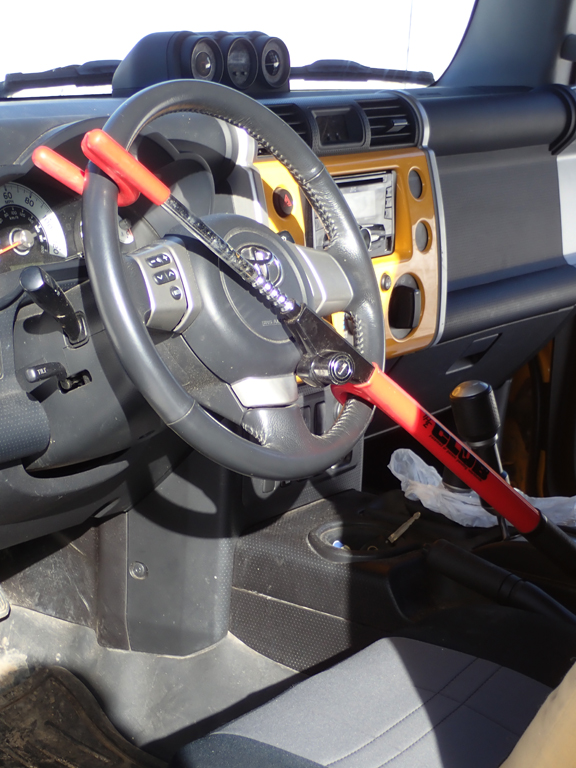 The last thing to be dealt with was the simplest, but can be the most necessary. It wasn’t too many years ago that if you parked your truck out on some deserted road, you needed to make sure that nothing of value was visible through the windshield and that you had some obvious anti-theft gear in place, else it was likely to be easy pickings for a less-than-honest passer-by. A blanket, preferably a stained one with holes, thrown over anything left inside hid it all from easy view, and a steering wheel locker worked just fine in dissuading someone from trying to take the whole rig.
The last thing to be dealt with was the simplest, but can be the most necessary. It wasn’t too many years ago that if you parked your truck out on some deserted road, you needed to make sure that nothing of value was visible through the windshield and that you had some obvious anti-theft gear in place, else it was likely to be easy pickings for a less-than-honest passer-by. A blanket, preferably a stained one with holes, thrown over anything left inside hid it all from easy view, and a steering wheel locker worked just fine in dissuading someone from trying to take the whole rig.
With new vehicles, the necessity for covering the contents is still there, but technology has advanced to the point where it has stymied the casual car thief. Without the properly programmed key or fob, newer vehicles won’t start. In vehicles of my FJ’s vintage the key has a little chip embedded in the grip: without that proper chip embedded in the key, the FJ won’t start. The chip key is the only way to start the engine. Unfortunately, should the electronics in the key be damaged, making a replacement key isn’t just a matter of going down to the hardware store and having the original key copied. The replacement costs a couple of hundred dollars and has to be obtained through a dealership. Hunting and fishing often entail getting soaking wet, or losing things that were thought to be securely stowed in a pocket. Electronics don’t like water, so whether the key is merely soaked or whether it is lost, it’s an expensive item to replace.
I paid a short visit to the hardware store and had a copy of my key made: the replacement key lacks the chip, so of course it won’t start the car, but it will open the door. This key was inexpensive, about 1% of the replacement cost of the full electronic key. Now, when I leave the FJ at the end of the road, I hide my regular key inside it, pocket the “dumb” key, lock the rig, and walk off. When I get back, I unlock the FJ, fetch out the hidden key, and I’m good to go.

Clockwise from top right, the "dumb" key that will only open the door; the fully electronic key; and a "valet" key that has the chip will start the engine, but lacks the remote door opener and the other bells-and-whistles, such as a "panic button."
PART TWO
 For a couple of decades I had a Jeep Wrangler that did that duty and did it well, but it did it completely without comfort. At temperatures that would turn honey solid, I had to wear full arctic gear if I wanted to go anywhere; parka, overpants, mittens or gloves, heavily insulated boots, and the like. When traveling in areas a lot further south than where I live, or later in the season, I’d just keep both windows (yep, just two: one on the driver’s and one on the passenger’s side) rolled down. Forget about listening to the radio or conversing with a passenger, because the “ambient noise” was just overwhelming. But it would take me out into the bush and bring me back.
For a couple of decades I had a Jeep Wrangler that did that duty and did it well, but it did it completely without comfort. At temperatures that would turn honey solid, I had to wear full arctic gear if I wanted to go anywhere; parka, overpants, mittens or gloves, heavily insulated boots, and the like. When traveling in areas a lot further south than where I live, or later in the season, I’d just keep both windows (yep, just two: one on the driver’s and one on the passenger’s side) rolled down. Forget about listening to the radio or conversing with a passenger, because the “ambient noise” was just overwhelming. But it would take me out into the bush and bring me back. 


 The shelf was made by planing down a 2x4 and a 2x6 to slightly more than an inch thickness; then they were tongue-and-groove joined together. Because all lumber is described as the dimension before sawing, the boards were about nine inches tall when joined. I added a bit of paneling that I had left over from a previous project as a bottom, plus a bit of similarly-left-over half-inch plywood as a top. Using contact cement, I covered the top with a thin (one-eighth inch) layer of rubber to prevent whatever I put on top of the shelf from sliding around too much.
The shelf was made by planing down a 2x4 and a 2x6 to slightly more than an inch thickness; then they were tongue-and-groove joined together. Because all lumber is described as the dimension before sawing, the boards were about nine inches tall when joined. I added a bit of paneling that I had left over from a previous project as a bottom, plus a bit of similarly-left-over half-inch plywood as a top. Using contact cement, I covered the top with a thin (one-eighth inch) layer of rubber to prevent whatever I put on top of the shelf from sliding around too much. 
 Once she had hers, she decided that I certainly needed one as well.
Once she had hers, she decided that I certainly needed one as well. 

 The last thing to be dealt with was the simplest, but can be the most necessary. It wasn’t too many years ago that if you parked your truck out on some deserted road, you needed to make sure that nothing of value was visible through the windshield and that you had some obvious anti-theft gear in place, else it was likely to be easy pickings for a less-than-honest passer-by. A blanket, preferably a stained one with holes, thrown over anything left inside hid it all from easy view, and a steering wheel locker worked just fine in dissuading someone from trying to take the whole rig.
The last thing to be dealt with was the simplest, but can be the most necessary. It wasn’t too many years ago that if you parked your truck out on some deserted road, you needed to make sure that nothing of value was visible through the windshield and that you had some obvious anti-theft gear in place, else it was likely to be easy pickings for a less-than-honest passer-by. A blanket, preferably a stained one with holes, thrown over anything left inside hid it all from easy view, and a steering wheel locker worked just fine in dissuading someone from trying to take the whole rig. 